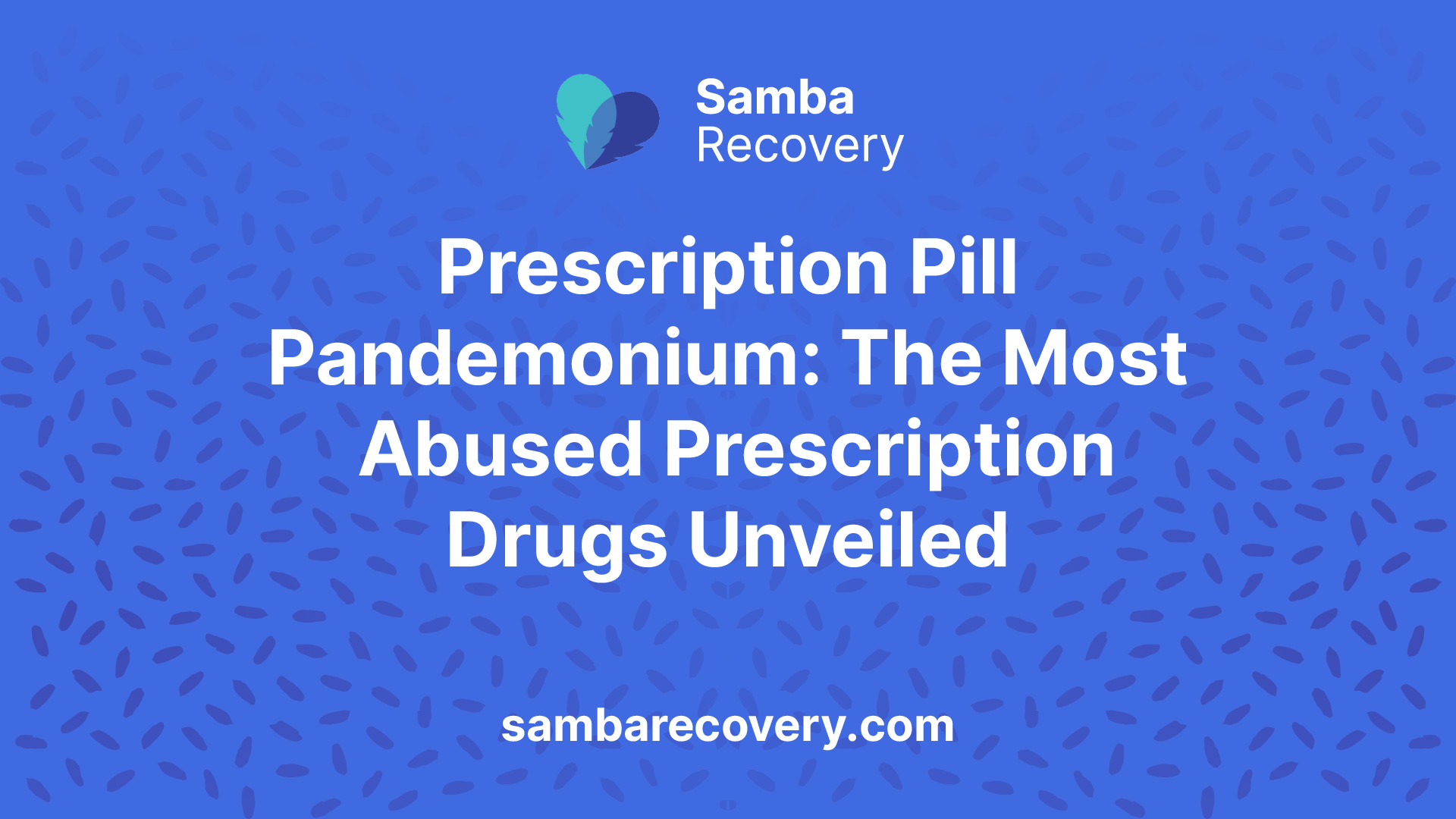Most Abused Prescription Drugs
Prescription drug abuse is a growing concern, with certain types of medications being more commonly misused than others. The most abused prescription drugs include opioid painkillers, anti-anxiety medicines, sedatives, and stimulants.
Opioid Painkillers
Opioid painkillers are powerful medications prescribed to manage severe pain. Unfortunately, they are also frequently misused due to their potential for addiction and euphoric effects. Commonly abused opioids include morphine and codeine. Brands such as Avinza, Kadian, and MS Contin fall under this category [1]. It’s important to note that the misuse of these drugs can have dangerous side effects and even lead to overdose.

Anti-Anxiety Medicines
Anti-anxiety medicines, also known as benzodiazepines, are prescribed to treat anxiety disorders and related conditions. These medications can produce a calming effect and are commonly misused for their sedative properties. Examples of frequently abused anti-anxiety medicines include Xanax, Ativan, and Valium. Misuse of these drugs can lead to physical and psychological dependence, as well as potential overdose risks. It’s crucial to use these medications only as directed by a healthcare professional.
Sedatives
Sedatives, also referred to as tranquilizers, are medications prescribed to alleviate sleep disorders and anxiety. They work by depressing the central nervous system, inducing relaxation and drowsiness. Some commonly abused sedatives include Ambien, Lunesta, and Sonata. It’s important to note that misuse of sedatives can lead to respiratory depression, unconsciousness, and even coma. These medications should only be taken under medical supervision.
Stimulants
Stimulant medications are primarily prescribed to treat attention deficit hyperactivity disorder (ADHD) and certain sleep disorders. They work by increasing alertness, attention, and energy levels. Stimulants like Adderall and Dextroamphetamine can be addictive and are often misused for their stimulating effects. High doses of stimulants can have severe consequences, including irregular heartbeat, dangerously high body temperature, and even cardiac arrest. Misuse of these medications can have serious health risks and should be avoided.
Understanding the most abused prescription drugs is essential for raising awareness about the potential dangers associated with their misuse. If you or someone you know is struggling with prescription drug abuse, it is important to seek help from a healthcare professional or addiction specialist. Remember, proper and responsible use of prescription medications is crucial for maintaining overall health and well-being.
Impact of Prescription Drug Abuse
Prescription drug abuse can have a significant impact on individuals, affecting various aspects of their lives. Understanding the consequences of this behavior is crucial in addressing the issue effectively.
Substance Use Issues
Misusing prescription drugs can lead to substance use issues, which can have far-reaching effects on individuals’ physical and mental health. It can result in dependency or addiction, making it difficult for individuals to function without the drug. The misuse of prescription drugs can also lead to the use of illicit substances as individuals seek more potent or easily accessible alternatives.
Effects on Work, Home, and Relationships
Prescription drug abuse can disrupt an individual’s ability to maintain stability in various areas of life. At work, it can lead to decreased productivity, absenteeism, and impaired decision-making. In the home, it can strain relationships with family members, leading to conflicts and breakdowns in communication. Additionally, prescription drug abuse can impact an individual’s ability to fulfill responsibilities, such as caring for children or managing household tasks.
Emotional Toll
Prescription drug abuse takes a toll on an individual’s emotional well-being. Feelings of shame, guilt, and isolation are common among those struggling with addiction. The misuse of prescription drugs can also exacerbate underlying mental health conditions, leading to increased anxiety, depression, or other emotional disturbances.
Overcoming prescription drug abuse can be challenging, and individuals often require support from their loved ones or professional organizations. Approaching a loved one about their prescription drug abuse can be difficult, as denial and anger are common reactions. It is important to approach the situation with empathy and understanding, seeking professional help if needed [2].
Understanding the impact of prescription drug abuse is essential in combating this issue. By raising awareness, providing support, and implementing preventative measures, we can work towards reducing the prevalence and negative consequences of prescription drug abuse. For more information on prevention and support, refer to our article on prescription drug monitoring programs and federal initiatives.
Diagnosis and Treatment
When it comes to addressing the issue of prescription drug abuse, accurate diagnosis and appropriate treatment are essential. This section will explore the process of identifying prescription drug abuse, available treatment options, and the importance of counseling.
Identifying Prescription Drug Abuse
Identifying prescription drug abuse typically involves a thorough evaluation by a healthcare professional. Doctors rely on medical history, conversations with the patient, and the presence of certain signs and symptoms to make a diagnosis [2]. Some common signs of prescription drug abuse may include:
- Frequent requests for prescription refills
- Taking higher doses or more frequent doses than prescribed
- Seeking prescriptions from multiple doctors
- Using prescription medications without a valid medical reason
- Changes in behavior, mood, or appearance
If you suspect that you or someone you know is struggling with prescription drug abuse, it is important to seek professional help. Early detection and intervention can significantly improve the chances of successful treatment.
Treatment Options
The treatment options for prescription drug abuse may vary depending on the specific drug being abused and the individual’s needs. In many cases, a comprehensive approach that combines different strategies is necessary. Some common treatment options include:
- Detoxification: This process involves safely managing withdrawal symptoms when an individual stops using the abused drug. Medical supervision and support are crucial during this phase.
- Medication-Assisted Treatment (MAT): Certain medications, such as buprenorphine or methadone, may be used to help manage withdrawal symptoms and reduce cravings for opioids.
- Behavioral Therapies: Counseling and behavioral therapies play a vital role in the treatment of prescription drug abuse. These therapies help individuals understand the underlying reasons for their drug abuse, develop coping mechanisms, and make positive behavioral changes.
- Support Groups: Participating in support groups, such as Narcotics Anonymous (NA) or SMART Recovery, can provide additional support and encouragement during the recovery process.
It’s important to remember that treatment plans should be tailored to the individual’s specific needs. A healthcare professional or addiction specialist can help determine the most appropriate treatment approach.
Importance of Counseling
Counseling is a crucial component of treatment for prescription drug abuse. It provides individuals with a safe and supportive environment to explore the underlying causes of their drug abuse, develop strategies for managing cravings and triggers, and learn healthy coping mechanisms [2]. Counseling can take various forms, including individual therapy, group therapy, or family therapy.
During counseling sessions, individuals can address the emotional and psychological aspects of their addiction and work towards building a strong foundation for recovery. They can learn to identify and manage triggers, develop healthier habits, and establish a support network to aid their journey to sobriety.
The guidance and support provided by a trained counselor or therapist are invaluable in helping individuals overcome prescription drug abuse. Counseling not only addresses the immediate challenges of addiction but also equips individuals with the tools and skills needed to maintain long-term recovery.
If you or someone you know is struggling with prescription drug abuse, remember that help is available. Reach out to a healthcare professional or addiction specialist to begin the journey towards recovery.
Commonly Abused Prescription Drugs
Prescription drug abuse is a significant issue, and several drugs are commonly misused for their euphoric effects. Understanding these drugs is crucial in addressing the problem. Here are some of the most abused prescription drugs:
Opioids: Morphine, Codeine
Among the most commonly abused prescription drugs are opioid painkillers such as morphine and codeine. These drugs, when taken in large doses, can produce a euphoric high and have dangerous side effects. Some brands of morphine include Avinza, Kadian, and MS Contin [1].
Oxycodone: OxyContin, Percocet
Oxycodone, found in medications like OxyContin and Percocet, is another opioid painkiller frequently abused. Individuals who misuse these drugs may crush, snort, or inject them, significantly increasing the risk of overdose. Street names for oxycodone include “oxy,” “O.C.,” “oxycotton” for OxyContin, and “percs” for Percocet or Percodan.
Hydrocodone: Vicodin, Lortab
Hydrocodone-containing drugs like Vicodin, Lortab, and Lorcet are also commonly abused. Taking high doses of hydrocodone can lead to dangerous breathing problems. Street names for Vicodin include “vike” and “Watson-387.” Physical dependence on hydrocodone may manifest as flu-like withdrawal symptoms.
Stimulants: Adderall, Dextroamphetamine
Stimulant medications prescribed for conditions like ADHD, such as Adderall and Dextroamphetamine, can be addictive. When abused, high doses of these stimulants can cause a dangerous rise in body temperature, irregular heartbeat, and even cardiac arrest. Street names for amphetamines include “bennies,” “black beauties,” and “speed”.
It is essential to be aware of the risks associated with these commonly abused prescription drugs. Understanding the dangers and seeking appropriate help and treatment is crucial for individuals struggling with prescription drug abuse. If you or someone you know is facing substance abuse issues, consider reaching out to healthcare professionals or support groups for assistance.
Risks and Consequences
Prescription drug abuse poses various risks and consequences to individuals. Understanding these risks is essential in raising awareness about the dangers of prescription drug abuse and promoting prevention efforts. Some of the significant risks and consequences associated with prescription drug abuse include overdose risk, physical dependence, and dangerous side effects.
Overdose Risk
One of the most significant risks of prescription drug abuse is the potential for overdose. In 2015, an estimated 52,204 deaths in the United States were attributed to prescription drug misuse, with opioids accounting for approximately 63.1% of these deaths [3]. Opioid painkillers, such as oxycodone (OxyContin, Percocet), are particularly concerning in terms of overdose risk. Crushing, snorting, or injecting these drugs significantly increases the risk of overdose [1]. It’s crucial to recognize the signs of an overdose and seek immediate medical attention if suspected.
Physical Dependence
Prescription drug abuse can lead to physical dependence on the medication. Drugs like hydrocodone (Vicodin, Lortab) that contain opioids can cause physical dependence, meaning the body becomes accustomed to the presence of the drug and requires it to function normally. Abruptly stopping the drug or reducing the dosage can result in withdrawal symptoms that mimic flu-like symptoms. Physical dependence on prescription drugs can complicate the process of recovery and may require professional medical assistance to manage effectively.
Dangerous Side Effects
Prescription drugs, when abused, can lead to a range of dangerous side effects. Stimulants like amphetamines (e.g., Adderall, Dextroamphetamine) used to treat ADHD can be addictive and, in high doses, can cause a dangerous rise in body temperature, irregular heartbeat, and even cardiac arrest. Other medications, such as dextromethorphan (DXM) found in over-the-counter cold and cough medicines, can cause hallucinations and a high feeling when taken in large doses. High doses of DXM can also result in vomiting, rapid heart rate, and, in rare cases, brain damage.
It is important to note that the risks and consequences of prescription drug abuse can vary depending on the specific drug and individual circumstances. Early intervention, education, and access to appropriate treatment are crucial in addressing the risks associated with prescription drug abuse and minimizing its consequences. To learn more about prevention and support options, consider exploring prescription drug monitoring programs, federal initiatives, and the development of abuse-deterrent formulations.
Prevention and Support
Addressing the issue of prescription drug abuse requires a comprehensive approach that includes prevention measures and support systems. Here are three key aspects of prevention and support in combating prescription drug abuse:
Prescription Drug Monitoring Programs
Prescription Drug Monitoring Programs (PDMPs) play a crucial role in monitoring the prescribing and dispensing of controlled prescription drugs. These state-run electronic databases help track the distribution of prescription drugs to patients. PDMPs have been associated with lower rates of opioid prescribing and overdose in some states [4].
These programs allow healthcare providers to access patient prescription history, enabling them to identify potential cases of misuse or abuse. By providing healthcare professionals with critical information, PDMPs help prevent the overprescribing and misuse of prescription drugs. However, it is important to address issues such as best practices, ease of use, and interoperability to maximize the effectiveness of PDMPs.
Federal Initiatives
Recognizing the urgency of combating prescription drug abuse, the federal government has implemented various initiatives to reduce overdose rates and prevent opioid use disorders. In 2015, coordinated federal efforts were initiated to address opioid misuse, addiction, and overdose. One such initiative is the National Institutes of Health’s Helping End Addiction Long-term (HEAL) Initiative, which focuses on advancing research to improve prevention and treatment strategies.
Additionally, the Centers for Disease Control and Prevention (CDC) issued the CDC Guideline for Prescribing Opioids for Chronic Pain in 2016. However, due to inconsistent policies and practices, an advisement against the misapplication of guideline recommendations was issued in 2019. The Department of Health and Human Services (HHS) also provided opioid tapering guidance for clinicians considering reducing opioid therapy for individuals with chronic pain.
These federal initiatives aim to provide guidelines, resources, and support to healthcare providers, policymakers, and communities in their efforts to address prescription drug abuse.
Development of Abuse-Deterrent Formulations
To combat the misuse of prescription drugs, manufacturers are working on developing abuse-deterrent formulations (ADF) of opioid medications. These formulations are designed to make it more difficult for individuals to misuse drugs by snorting or injecting them. The FDA has also called for the development of ADF stimulants. Studies have shown that ADF opioids decrease the illicit value of drugs, and regulations on medication have effectively reduced the prescribing of opioid medications [4].
By creating medications with abuse-deterrent properties, manufacturers aim to reduce the likelihood of misuse and promote safer medication practices. These innovations in medication formulations contribute to the prevention of prescription drug abuse.
Prevention and support efforts, such as the implementation of PDMPs, federal initiatives, and the development of abuse-deterrent formulations, play a crucial role in addressing prescription drug abuse. By combining these strategies with education, awareness, and accessible treatment options, we can work towards reducing the prevalence of prescription drug abuse and supporting individuals on the path to recovery.
References
[1]: https://www.webmd.com/mental-health/addiction/ss/slideshow-commonly-abused-drugs
[3]: https://www.ncbi.nlm.nih.gov/pmc/articles/PMC10198020/
[4]: https://nida.nih.gov/publications/research-reports/misuse-prescription-drugs/how-can-prescription-drug-misuse-be-prevented






